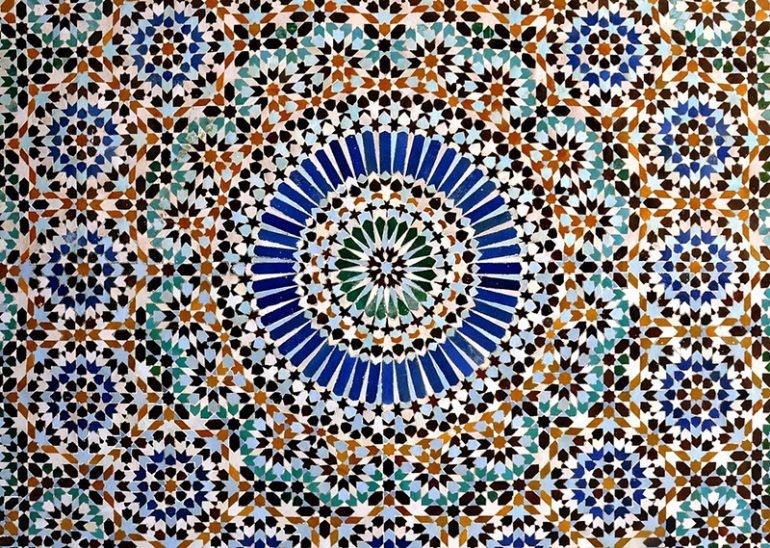بلاگ
Unraveling the History of Islamic Geometric Patterns
Islamic geometric patterns have a rich and fascinating history, spanning over a millennium and encompassing a wide range of cultures and artistic traditions. From the intricate tilework of the Alhambra Palace in Spain to the soaring domes of Istanbul mosques, Islamic geometric patterns have long been admired for their beauty, complexity, and spiritual significance.
Islamic geometric patterns are used in architecture and decorative art throughout the Muslim world. These patterns are created using a variety of shapes and geometric grids and often incorporate Islamic calligraphy and nature motifs.

Islamic geometric patterns date back to the seventh century, when Islam emerged as a major world religion. In the centuries that followed, Islamic scholars and artists drew on a wide range of mathematical and artistic traditions to create a distinctive geometric design style. One of the key influences was the Greek tradition of geometric ornamentation. This tradition was brought to the Islamic world through Greek texts translated into Arabic. Islamic scholars also drew on the Persian and Indian mathematics traditions, which had already developed sophisticated systems of geometry and arithmetic.
Islamic scholars combined these different traditions to create their own unique style of geometric design. This style featured complex patterns that incorporated interlocking geometric shapes, calligraphic elements, and intricate color palettes. Islamic geometric design was used in many different forms of art, from architecture and carpets to pottery and metalwork.
Islamic geometric patterns reached new heights of sophistication during the Islamic Golden Age, which lasted from the eighth to the thirteenth centuries. During this period, Islamic scholars made major advances in mathematics, astronomy, and other sciences. These advances profoundly influenced Islamic art and design. Islamic geometric patterns became more complex and refined, incorporating a wider range of shapes and mathematical principles. Islamic art used geometric patterns not limited to decorative purposes; it also served a symbolic function. For example, star-shaped patterns were believed to symbolize divine order, while hexagons were associated with unity.
One of the most remarkable examples of Islamic decorative patterns is the Alhambra Palace in Granada, Spain. Built during the 14th century, the Alhambra is renowned for its intricate tilework, which incorporates a wide range of geometric patterns. The use of geometric patterns in the Alhambra was not only decorative; it also served a practical purpose, regulating the temperature and humidity inside the palace. The use of water features, such as fountains and pools, also helped cool the air and create a pleasant atmosphere.
Islamic geometric patterns continued to evolve in the centuries that followed. This was because Islamic artists and architects drew on a wide range of influences, including Byzantine, Chinese, and European art. During the Ottoman Empire, which lasted from the 14th to the early 20th centuries, Islamic geometric patterns reached new heights of complexity and sophistication. Ottoman architects created stunning mosques and palaces, such as the Blue Mosque in Istanbul and the Topkapi Palace. These mosques incorporated a wide range of geometric gereh patterns, including complex star-shaped designs and intricate calligraphic inscriptions.
Artists, architects, and designers have been inspired by the beauty of Islamic geometric patterns in recent years. Through the use of digital technologies and new materials, artists and designers have reinterpreted and adapted Islamic geometric patterns to create innovative and striking works that are reinterpreted and adapted. Anila Quayyum Agha, for instance, has created intricate patterns based on Islamic design using light and shadow.
Her intricate patterns and sculptures have been exhibited in galleries around the world and have won multiple awards. Her work demonstrates the power of Islamic geometry to captivate and inspire modern audiences.
She continues to experiment with new materials and shapes to create unique pieces of art. Her work has been praised for its complexity and beauty, and has been featured in international publications and renowned museums. She is one of the leading contemporary artists in the field of Islamic geometry.
In conclusion, Islamic geometric patterns have a rich and fascinating history, spanning a millennium. They encompass a wide range of cultures and artistic traditions. From their origins in the seventh century to their continued influence on contemporary art and design, Islamic geometric patterns have been admired for their beauty, complexity, and spiritual significance. Their use in Islamic art and architecture reflects a deep and enduring fascination with geometry and mathematics. Their symbolic significance reflects Islamic philosophy and spirituality's profound influence on Islamic artistic traditions.
